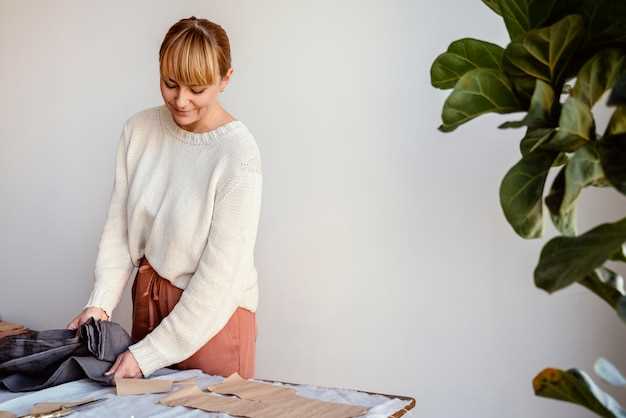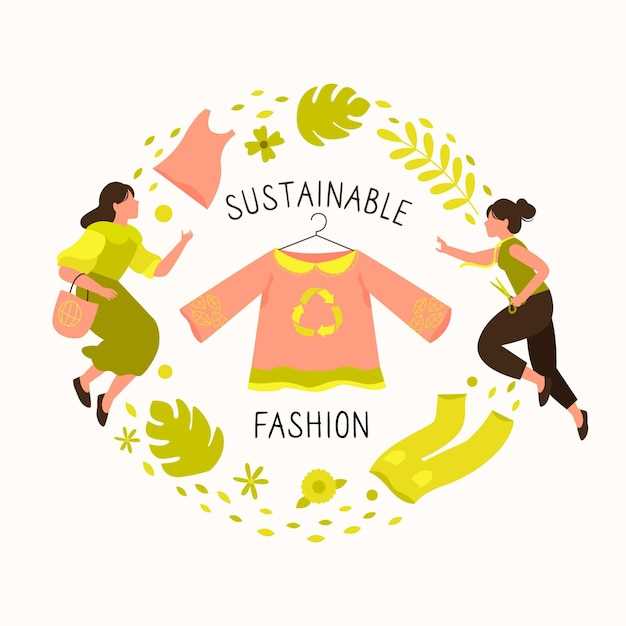The world of attire is undergoing a remarkable transformation. Increasingly, individuals seek to align their wardrobe with their values. Each piece tells a story. Each selection reflects a deeper awareness. This shift signals a move towards responsibility, where personal aesthetics harmonize with ecological mindfulness.
In recent years, the spotlight has turned to the way apparel impacts our planet. Consumers are now questioning the origins of their clothing and the processes involved in creating them. The journey towards improved choices is not just a passing phase; it’s a renewed commitment to making informed decisions. As more brands adopt innovative practices, the landscape of clothing is rapidly changing, offering new opportunities for expression.
Materials become essential. Everything from organic fibers to recycled resources brings excitement. It’s no longer solely about looking good; it’s about feeling right. Sustainable innovations come to the forefront, showcasing creativity in a responsible manner. This evolution encourages every individual to explore the intersection of beauty and ethical consumption.
As we navigate this evolving landscape, the new focus invites a fresh perspective on appearance. No longer are superficial choices the norm. Conscious engagement with our garments fosters authenticity. A deliberate approach leads to connections with what we wear and with ourselves. The upcoming season promises vibrant colors, unique patterns, and imaginative designs–all coupled with a commitment to making a positive impact.
Top 2024 Fashion Trends: Embrace Sustainability

In recent years, the apparel landscape has experienced a profound transformation. Shoppers are increasingly inclined to seek solutions that respect both the planet and its inhabitants. Awareness about the environmental impacts of clothing production has spread widely. Today’s consumers desire options that align with their values, merging beauty with responsibility.
Innovative materials and practices are gaining prominence. Designers are exploring organic fabrics, recycled materials, and zero-waste techniques. As a result, the industry is evolving to meet the growing demand for eco-friendly choices. This shift is not merely a trend; it represents a fundamental change in how clothing is conceived, created, and consumed.
The rise of circular fashion is reshaping traditional approaches. It’s about ensuring longevity and giving garments a second life. From thrift shopping to rental services, there’s something for everyone. These alternatives challenge the fast-fashion model. They invite consumers to rethink their purchasing habits.
| Innovative Approaches | Benefits |
|---|---|
| Organic Cotton | Reduces chemical usage, promotes biodiversity |
| Recycled Polyester | Lowers waste in landfills, conserves resources |
| Upcycling | Creatively repurposes old garments, minimizes textile waste |
| Rental Services | Access to high-quality pieces without ownership |
| Thrift Shopping | Unique finds with little environmental footprint |
As we navigate through this pivotal moment in the industry, choices that promote a more responsible way of living will become increasingly popular. Fashion enthusiasts are intentionally selecting pieces that not only reflect their taste but also demonstrate respect for the environment. This elevated consciousness is changing the conversation around what it truly means to be fashionable.
Sustainable Fashion Choices for 2024

In a world where the consequences of consumption are becoming increasingly evident, individuals are seeking alternatives that reflect their values. Approaches that prioritize ecological balance and social responsibility are gaining momentum. Small adjustments in personal wardrobe can lead to significant impacts. Conscious consumers are leading the charge towards a more thoughtful way of dressing.
Exploring second-hand options or vintage finds can introduce unique pieces into one’s closet. Renting garments for special occasions not only reduces waste but also provides access to high-quality items without breaking the bank. Fabric technology has advanced remarkably, allowing for the creation of materials that require fewer resources and have a minor ecological footprint. Brands that prioritize transparency in their production processes are becoming essential partners for the discerning shopper who values integrity.
Moreover, engaging with local artisans and supporting small businesses fosters community connections and promotes craftsmanship. With a diverse array of choices available, it is easier than ever to align purchasing decisions with personal ethics. Understanding the story behind each item worn can transform one’s approach to fashion, turning a simple garment into a symbol of commitment to a better world.
Understanding Eco-Friendly Fabrics
As awareness of environmental issues grows, more people are seeking materials that minimize harm. It’s not just about looking good anymore; it’s also about feeling good about what you wear. Fabrics can be produced in ways that honor the planet and its resources. Different types of materials come with distinct benefits, and every choice can make an impact.
Natural fibers often stand out due to their biodegradability. For instance, cotton, when grown organically, uses fewer harmful chemicals. Another example is linen, which requires less water and does not rely on pesticides. These choices contribute to a smaller ecological footprint.
Recycled materials represent an innovative approach to fabric production, diverting waste from landfills. Items made from post-consumer plastics offer a fresh alternative. They utilize discarded resources and transform them into beautiful textiles. This not only helps reduce waste but also conserves energy and raw materials.
In addition to these options, there are innovations in textiles made from unconventional sources. Fabrics derived from bamboo, hemp, or even milk proteins exhibit impressive qualities. They are soft, breathable, and often more environmentally friendly than traditional textiles. As brands begin to explore these new avenues, the potential for creativity and diversity within eco-conscious materials expands.
Choosing fabrics thoughtfully means considering a variety of factors, such as durability and production methods. Some materials require extensive water use or chemical treatments, while others might thrive on minimal resources. The beauty lies in recognizing the differences and making informed decisions that align with personal values.
The Rise of Circular Fashion
A shift in consumption habits is taking place, inviting a new era of innovative practices. This movement focuses on rethinking how clothing is produced, consumed, and disposed of. With increasing awareness of waste and environmental impact, numerous individuals are opting for more responsible choices. The circular approach promotes reutilization and recycling, fostering a system where value is preserved.
People are becoming more conscious of their purchases. They want to know the journey behind their garments. This change in mindset has led to the emergence of creative designs that focus on longevity. Brands are reimagining materials too, utilizing resources that can be returned to the earth after use.
- Repairing and upcycling are becoming popular among consumers.
- Rental services are on the rise, challenging traditional purchasing habits.
- Transparency is key; buyers seek information on sourcing and impact.
By encouraging a lifecycle where products are designed to last and can be continuously recycled or reused, the industry can reduce waste significantly, ultimately transforming the way garments are perceived and utilized across the globe.
- Understand the importance of durability in clothing.
- Support brands that prioritize eco-friendly materials.
- Participate in clothing swaps or rental opportunities.
The future is bright for approaches that reward resourcefulness, creating a happier planet and a more thoughtful community of consumers.
Ethical Brands to Watch This Year
This year, an array of brands is emerging with a promise of responsibility and conscious creation. Consumers are seeking more than just aesthetics; they desire transparency and integrity. The market is shifting toward apparel that respects both people and the planet. Choices matter more than ever. Those motivated by ethical practices are stepping into the spotlight.
Here are some noteworthy names to keep an eye on:
- Everlane
- Patagonia
- Reformation
- People Tree
- Veja
Each of these brands stands out not just for their appealing designs, but also for their commitment to ethical production processes and sustainable materials, which resonate deeply with the values of contemporary consumers.
As you explore these options, consider how supporting such businesses can contribute to a more equitable marketplace. It’s about aligning personal aesthetics with a broader mission. Thoughtful selections lead to impactful changes. Additionally, many of these companies are actively engaging in community projects and environmental initiatives.
- Look for brands that prioritize fair labor practices.
- Choose companies that use eco-friendly materials.
- Support local artisans and small manufacturers.
The influence of these ethical brands is expanding, encouraging customers to rethink their purchasing decisions while simultaneously fostering a culture of social responsibility that benefits everyone involved.
Vegan Leather and Its Benefits
In recent years, a growing number of individuals have begun to explore alternative materials. One such innovation is a plant-based substitute for traditional leather. This option not only meets aesthetic desires but also aligns with ethical considerations. There’s a noticeable shift towards materials that support a compassionate lifestyle. More people are choosing to incorporate these alternatives into their wardrobes.
This fabric offers an array of advantages. First, it helps reduce animal cruelty. By eliminating the need for animal hides, consumers directly support more humane practices. Additionally, vegan leather contributes to environmental preservation as it often serves as a more eco-friendly option. It’s crafted from various sources, such as fruits, vegetables, and synthetic materials, leading to less waste and a smaller carbon footprint. Consequently, the production process for these alternatives generally consumes fewer resources than traditional leather tanning.
Longevity and durability are significant features of this material. Many products made from vegan leather are designed to withstand wear and tear. They often replicate the luxurious feel of genuine leather, making them desirable for various items, including bags and jackets. Moreover, maintenance is usually easier. Cleaning vegan leather is straightforward, requiring simply a damp cloth for most spills. Unlike its animal-based counterpart, it does not require special treatments or conditioning, which adds to its practicality.
As innovation continues to evolve, the market for vegan alternatives is expanding. New designs appear regularly, showcasing an exciting blend of creativity and ideology. The emergence of diverse textures and finishes allows for unique expressions, catering to varied tastes. This is not just about fashion; it reflects a broader cultural movement. People are increasingly choosing products that resonate with their values, making informed decisions that prioritize well-being and responsibility.
In conclusion, adopting vegan leather can be a choice driven by a multitude of factors. It stands as a testament to personal values and the desire for a better world. The benefits extend beyond aesthetics, emphasizing compassion for animals and care for the planet. By integrating these materials into everyday life, individuals can enjoy beautiful items while contributing to positive change.
Must-Have Trends for Summer 2024

The upcoming summer season invites exploration into innovative looks that reflect personal values and contemporary aesthetics. There’s an unmistakable shift toward choices that resonate with mindful living. As the warmth envelops us, refreshing your wardrobe with key pieces becomes essential. Fresh palettes, unique textures, and inspired silhouettes promise to redefine how we express ourselves. This summer, let’s dive into the must-have items that will perfectly complement your adventures. Expect not just clothing, but statements that tell a story.
Comfortable yet striking ensembles are at the forefront. Bold colors and patterns are making waves. Think breathable fabrics for those sunny days. Accessories take on new forms, becoming artworks in their own right. Each garment should reflect individuality and purpose, so choose thoughtfully.
| Trend | Description |
|---|---|
| Vibrant hues | Bright and lively shades dominate this summer, evoking joy and energy. |
| Lightweight layers | Sheer fabrics allow for versatility while ensuring breathability in heat. |
| Artful accessories | Statement pieces that reflect creativity will enhance everyday outfits. |
| Nature-inspired prints | Floral and botanical designs connect with the beauty of the outdoors. |
| Eco-friendly materials | Fabrics made from recycled sources support a conscious consumer approach. |
This season radiates optimism, championing individuality and creativity. Each choice made contributes to a broader narrative about who we are. As you curate your summer selections, remember that each item carries significance. It’s about feeling good in what you wear while staying true to your beliefs. Let your wardrobe reflect not just trends, but your journey and perspectives.
Color Palettes Inspired by Nature
Nature offers a delightful range of hues that captivate and inspire. Observing landscapes, we can find an endless variety of combinations. Forest greens, ocean blues, golden sunsets, and earthy browns blend into captivating palettes. These natural tones evoke feelings of calmness and connection. They invite us to appreciate the organic beauty surrounding us.
Imagine walking through a lush forest, where vibrant foliage dances in the sunlight. The interplay of colors creates a symphony for the eyes. Each season brings a new palette, from the blooming pastels of spring to the rich, fiery shades of autumn. Such variations spark creativity and encourage choices that resonate with our surroundings, allowing us to express ourselves in harmony with the environment.
Incorporating these tones into our clothing can transform a simple outfit into a work of art. Using shades inspired by flora and fauna not only enhances personal aesthetic but also fosters an appreciation for the planet. The deep blues of the ocean mirror serenity, while warm clay tones bring a sense of grounding. Letting nature guide color choices can lead to a wardrobe that feels both refreshing and timeless.
Timeless Styles Versus Fast Fashion
The landscape of clothing consumption is continually evolving. There exists a stark contrast between enduring designs and quick, fleeting trends. While some pieces become cherished staples, others quickly fade from memory. This division influences not only personal wardrobes but also broader societal values.
Enduring garments hold natural appeal. They often feature classic silhouettes. Their versatility allows for countless pairings, suiting various occasions.
- Classic cuts transcend seasons.
- Neutral colors provide a solid foundation for any outfit.
- High-quality materials ensure longevity and comfort.
In contrast, the realm of rapid production showcases a different story; items created hastily often lack authentic character and durability, leading to a cycle where consumers continually seek the next fleeting item, contributing to environmental concerns and an incessant desire for novelty, fostering a mindset that prioritizes quantity over quality, ultimately encouraging a throwaway culture that disregards the value of craftsmanship.
In conclusion, recognizing this dichotomy is essential. It invites us to reconsider our choices. Investing in pieces that stand the test of time enriches personal expression. Meanwhile, indulging in ephemeral trends risks overshadowing genuine style. Making informed decisions leads to a more meaningful wardrobe. This journey ultimately reflects deeper values about consumption in a rapidly changing world.
Accessorizing with Responsibility
Choosing accessories is more than just completing an outfit. It’s about making choices that reflect your values. Every piece tells a story. It can enhance your appearance while supporting a greater cause. The journey of responsible accessorizing begins with awareness.
Consider the materials used in the items you select. Look for those made from upcycled or organic materials. These options often carry with them a sense of history and purpose. Handmade products can also showcase the craftsmanship of artisans. By opting for unique pieces, you often contribute to local economies.
Sourced from ethical producers, jewelry can carry powerful messages. Each ring, bracelet, or necklace can symbolize commitment to social responsibility. Vintage accessories not only add character but reduce demand for new items. This practice promotes a culture of reuse and creativity.
Additionally, supporting brands that prioritize transparency can foster trust. Seek out companies that openly share their sourcing and production methods. A transparent approach indicates a genuine commitment to environmental care. These choices empower you to represent your personal beliefs through your accessories.
When you wear something that aligns with your principles, it feels right. You become a walking testament to your values, inspiring others around you. The creation of a fashionable persona can thus be an expression of who you are. After all, true elegance combines beauty with conscience.
Accessorizing mindfully invites you to think critically about your selections. You hold the power to drive change with each item you adorn. Choose wisely, for every adornment can become a statement of intent. The world of accessories is rich with options waiting to be explored.
Video:
8 Sustainability ideas that will change the world | FT Rethink
8 Sustainability ideas that will change the world | FT Rethink by Financial Times 301,132 views 2 years ago 5 minutes, 3 seconds
Q&A:
What are the key trends in sustainable fashion for 2024?
In 2024, some key trends in sustainable fashion include the rise of circular fashion, where brands emphasize recycling and upcycling materials. Additionally, there is a growing popularity of bio-based fabrics made from natural and renewable resources, such as organic cotton, hemp, and Tencel. Ethically sourced materials and transparent supply chains are also trends to look out for, as consumers increasingly demand accountability from brands regarding their sourcing practices. Furthermore, thrift shopping and second-hand clothing continue to gain traction, driven by the desire to reduce waste and promote unique personal styles.
How can I incorporate sustainable fashion choices into my wardrobe?
Incorporating sustainable fashion into your wardrobe can be achieved through several practical steps. Firstly, consider investing in high-quality, timeless pieces that will last longer, reducing the need for frequent replacements. Secondly, explore thrift stores or online second-hand platforms for unique finds. Look for brands that prioritize ethical production methods, including organic materials and fair wages for workers. Furthermore, consider hosting clothing swaps with friends to refresh your wardrobe without purchasing new items. Finally, educate yourself about the environmental impact of different fabrics and make conscious choices when shopping.
Are there specific brands I should support that focus on sustainable fashion?
Yes, there are numerous brands committed to sustainable fashion that you can support. Some notable examples include Patagonia, known for its eco-friendly outdoor gear and commitment to environmental activism; Reformation, which creates trendy clothing using sustainable practices; and Eileen Fisher, which emphasizes timeless designs made from organic and recycled materials. Additionally, brands like Everlane focus on transparency in their pricing and supply chain. Supporting these brands helps promote ethical practices in the fashion industry and encourages more brands to adopt sustainable measures.
What is the environmental impact of fast fashion, and why should I avoid it?
Fast fashion has a significant negative impact on the environment due to its mass production and consumption nature. It leads to high levels of waste, as clothes are often discarded after a few uses. The industry is also a major contributor to pollution; the production process consumes vast amounts of water and uses harmful chemicals that can contaminate water sources. Moreover, fast fashion relies on synthetic materials which contribute to microplastic pollution in our oceans. By avoiding fast fashion, you can help reduce your carbon footprint and support a more responsible and sustainable fashion ecosystem.
How can I educate myself about sustainable fashion practices?
Educating yourself about sustainable fashion practices is a valuable pursuit, and there are many resources available. Start by reading books and articles focused on sustainable fashion; titles like “Dress Sustainable” or blogs dedicated to eco-conscious living can provide insight. David Suzuki Foundation and Fashion Revolution are excellent online platforms that offer information on ethical practices in the fashion industry. Additionally, consider following influencers and brands on social media that advocate for sustainable practices. Participating in workshops or online courses can also enhance your knowledge and help you make informed choices when shopping.
What are some of the key sustainable fashion trends expected in 2024?
In 2024, some of the key sustainable fashion trends include the rise of circular fashion, which emphasizes recycling and reusing materials to minimize waste. Additionally, we can expect an increased popularity of eco-friendly fabrics such as organic cotton, Tencel, and recycled polyester. Fashion brands are also diving into transparency, providing consumers with information about where their materials come from and the production processes involved. Another trend is the shift towards rental and second-hand clothing, as more people seek to reduce their environmental footprint by opting for pre-owned items. Overall, the focus is on creating a wardrobe that is not only stylish but also ethically made and environmentally friendly.


